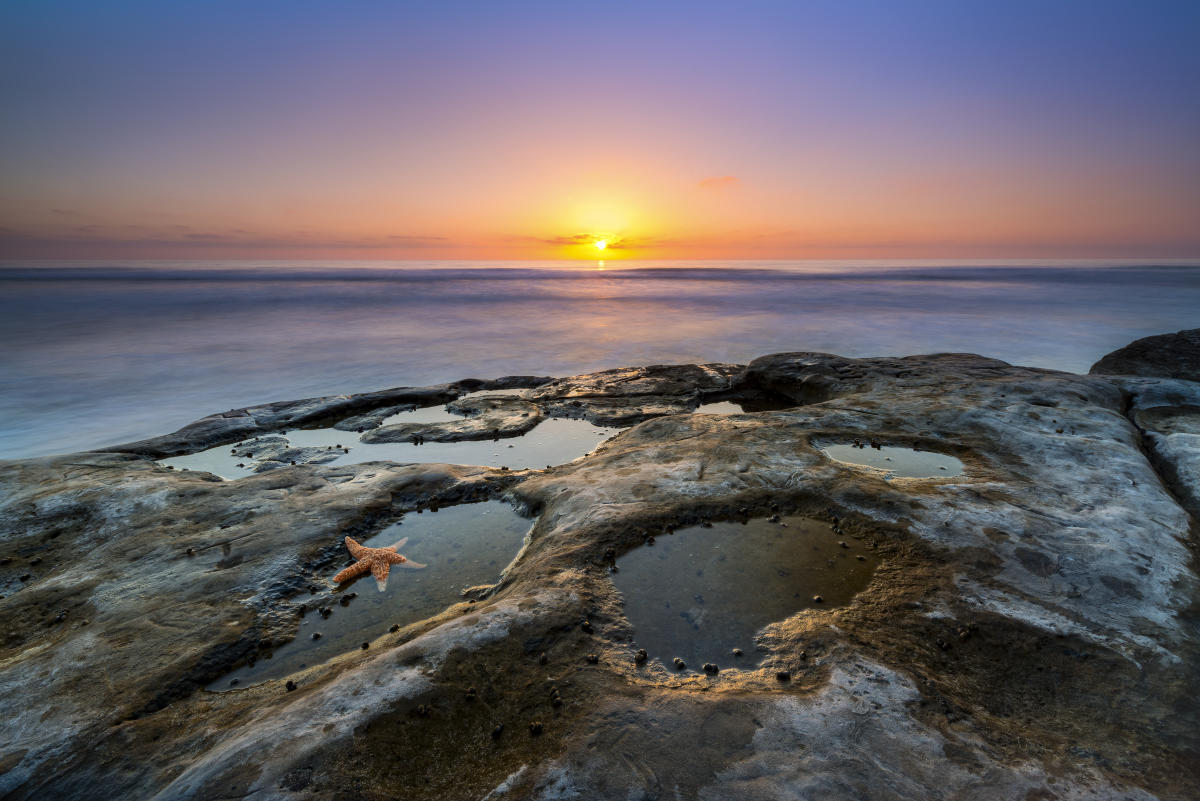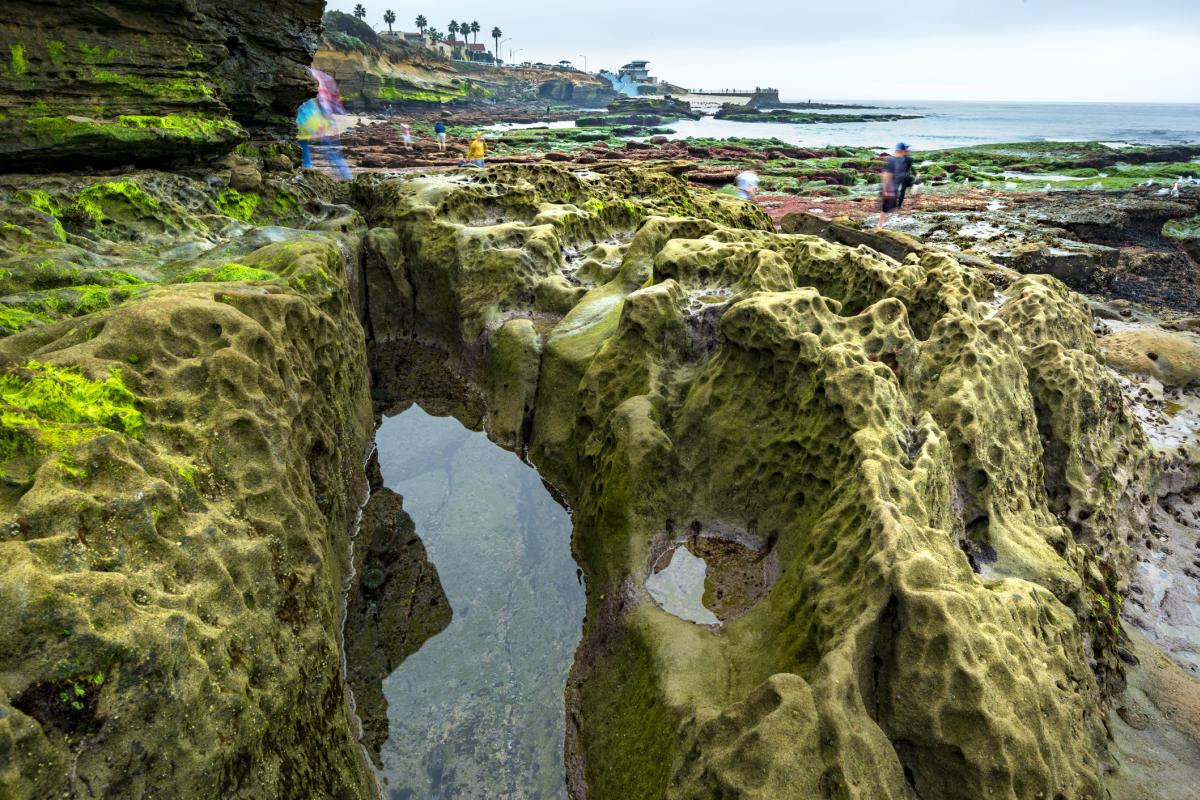Top San Diego Tidepools: Best Spots & Tips for Exploration
San Diego offers some of the best tidepools for exploring marine life up close. In this guide, we will highlight the top San Diego tidepools locations, what you’ll see, and tips for a great visit.
Key Takeaways
-
San Diego’s coastal tide pools offer accessible, year-round opportunities to explore diverse marine life, thanks to the region’s rocky coastline and temperate climate.
-
Top tide pooling spots in San Diego include family-friendly locations like Coronado Beach and Ocean Beach, as well as secluded areas like False Point and Shell Beach, each home to unique marine species.
-
For a successful tide pooling adventure, visit during low tides between November and March, wear protective footwear, and follow etiquette guidelines to protect the delicate ecosystems.
Understanding Tide Pools in San Diego

Image by Michael Ver Sprill
Tide pools are nature’s miniature aquariums, formed in rocky coastal areas where seawater gets trapped during low tides. These shallow pools create a dynamic and diverse environment, home to a variety of marine life adapted to withstand fluctuating water levels and conditions.
San Diego is an ideal destination for tide pooling, thanks to its rocky coastline that reveals a wealth of tide pools at low tide. From the bustling shores of La Jolla to the serene stretches of Solana Beach, San Diego’s tide pools offer a window into the underwater world without needing to dive in.
What Are Tide Pools?
Tide pools are rocky pools by the ocean filled with seawater, often found in rugged areas where the coastline meets the sea. They form when waves driven by storms or high winds push sand and stones to create mounds that trap water. These pools are divided into different zones:
-
The splash zone
-
High tide zone
-
Middle tide zone
-
Low tide zone
Each zone hosts distinct types of marine life, making tide pools incredibly biodiverse.
In the splash zone, you might find hardy invertebrates like periwinkle snails and shore crabs. The high tide zone hosts barnacles and limpets, while the middle tide zone is home to California mussels, anemones, and sea hares. The low tide zone, exposed only during very low tides, reveals more delicate creatures like sea stars and sea urchins. This zonation helps tide pool inhabitants survive the challenges of their ever-changing environment.
Why San Diego for Tide Pooling?
San Diego’s coastline boasts a unique combination of features, climate, and biodiversity that make it a prime location for tide pooling. With a 70-mile stretch of coastline, San Diego offers a variety of rocky beaches and intertidal zones, each teeming with marine life.
The temperate climate allows for year-round exploration, and the diverse habitats ensure that every visit to the tide pools can reveal new and exciting discoveries.
Best Tide Pool Spots in San Diego

Image by 4kodiak
San Diego is home to some of the best tide pooling spots in California, each offering a unique experience. From the family-friendly Coronado Beach to the secluded False Point in La Jolla, there’s a tide pool for every adventurer, including the fascinating La Jolla tide pools.
Here are the top 10 tide pool locations in San Diego County, each offering a unique opportunity to experience these natural wonders and discover the incredible marine life they host.
Coronado Beach Tide Pools

Image by californiasbestbeaches.com
Coronado Beach, located in front of the iconic Hotel del Coronado, is a fantastic spot for family-friendly tide pooling. These tide pools are easily accessible and safe for children, making them perfect for a day of exploration with the little ones. As you wander through the shallow pools, you’ll encounter:
-
sea anemones
-
barnacles
-
crabs
-
little fish
-
starfish
-
limpets
-
mussels
-
goose-neck barnacles
These creatures add to the diversity of marine life in the tide pools.
After exploring the tide pools, you can enjoy a meal at nearby eateries like the Beach & Taco Shack or treat yourself to some gelato at Sundaes. Parking is available at the resort for a fee, or you can find street parking nearby.
Coronado Beach offers a delightful blend of natural beauty and convenience, ensuring a memorable tide pooling experience.
Cabrillo National Monument Tide Pools

Image by AutumnSkyPhotography
The Cabrillo National Monument tide pools are a must-visit for any tide pooling enthusiast. Located beneath the sandstone cliffs of Point Loma, these tide pools are home to an impressive array of marine life. In the middle intertidal zone, you can find California mussels, keyhole limpets, periwinkle snails, and Kellet’s whelks. The pools also host sandcastle worms, sea hares, crabs, sculpin, octopi, shrimp, starfish, brittle stars, sea urchins, and even lobsters.
Beyond the tide pools, the Cabrillo National Monument offers stunning views of San Diego Bay and the Pacific Ocean. The historic Point Loma Lighthouse adds a touch of history to your visit. To access the tide pools, enter the park, pay the entrance fee, and follow the signs to the tide pool area. This spot combines rich marine biodiversity with breathtaking scenery, making it a highlight of any tide pooling adventure.
Sunset Cliffs Natural Park

Image by 4kodiak
Sunset Cliffs Natural Park is renowned for its rocky terrain and vibrant sea life. Located between Point Loma and Ocean Beach, this park offers accessible and scenic locations for tide pooling. The tide pools here are teeming with fish, sea anemones, and tiny crabs, making it an ideal spot for both marine exploration and sunset viewing.
The stairs near the corner of Ladera Street and Sunset Cliffs Boulevard lead you down to these fascinating pools, where you can experience the natural wonders up close.
Ocean Beach Tide Pools

Image by Anthony Mance
The tide pools at Ocean Beach are a favorite among families due to their kid-friendly nature. Located near the OB Pier, these pools feature flat rocks and shallow waters, making them safe and easy to explore with children. In this area, you can observe a variety of marine life such as sea anemones, barnacles, limpets, and sea grasses. Additionally, you may also encounter hermit crabs and small snails.
The gentle waves and calm environment make Ocean Beach an excellent place to introduce young ones to the wonders of tide pooling.
Tourmaline Surf Park Tide Pools
Tourmaline Surf Park, located north of the surfing area, is known for its rich marine life and large boulder field. During low tide, you can observe:
-
Hermit crabs
-
Red thatched barnacles
-
Aggregating and solitary anemones
-
Limpets
-
Tube snails
The algae-covered rocks can be slippery, so it’s important to wear protective footwear.
This spot offers a mix of tide pooling and surfing, making it a versatile destination for outdoor enthusiasts.
False Point Tide Pools
False Point in La Jolla offers a secluded tide pooling experience with diverse marine life and stunning sunset views. This area is perfect for those looking to escape the crowds and enjoy a tranquil tide pooling adventure. The tide pools at False Point are home to:
-
Hermit crabs
-
Sea anemones
-
Brittle stars
-
Sea urchins
-
Occasionally lobsters
The serene environment and beautiful scenery make it a hidden gem in San Diego.
Shell Beach Tide Pools
Shell Beach, located at the southern end of Ellen Browning Scripps Park in La Jolla, is a tide pooling hotspot. The colorful marine life and abundance of seashells make it a popular destination for families and nature enthusiasts.
You can access the tide pools via a small cement stairway at the southern end of the park. Here, you’ll find a variety of marine creatures, including hermit crabs, sea anemones, and seagrasses.
Dike Rock Tide Pools
Dike Rock, located north of Scripps Pier and La Jolla Shores beach, is known for its volcanic rocks and rare sea creatures. This spot is perfect for those looking to encounter unique marine life, such as tiny Pacific octopi and hermit crabs.
The nearby Birch Aquarium offers guided tide pooling tours during the winter season, providing an educational and interactive experience for visitors.
Cardiff State Beach Tide Pools
Cardiff State Beach, located 30 minutes north of La Jolla, is renowned for its fossil clams and starfish. The tide pools here are situated south of lifeguard tower No. 10 and feature:
-
45-million-year-old flat rocks
-
tiny fish
-
sea anemones
-
clam fossils
This spot offers a glimpse into the ancient marine history of the area, making it a fascinating destination for tide pooling.
Swami's State Beach Tide Pools
Swami’s State Beach in Encinitas is a popular surf spot that also offers excellent tide pooling opportunities. Located next to the Self-Realization Fellowship, the beach features stairs down to the tide pools, where you can find sea hares and brittle stars.
After exploring the tide pools, you can take a scenic walk to San Elijo Lagoon, making Swami’s a perfect spot for a day of adventure and relaxation.
Tips for a Successful Tide Pooling Adventure
For a safe and enjoyable tide pooling experience, being well-prepared is key. The difference can be made by knowing the best times to visit, bringing the right gear, and adhering to proper etiquette.
Here are some tips to help you make the most of your tide pooling adventure in San Diego.
Best Times to Visit
Between November and March is the best time to visit tide pools in San Diego. This is when low tides occur during daylight hours. The two hours before and after low tide provide the best viewing opportunities, so it’s important to check the tide charts for times when tides are close to 0 or negative.
Although tide pooling is possible during the summer, it’s advisable to check tide charts and plan for early morning low tides.
Essential Gear
Navigating the rocky and slippery terrain of tide pools requires proper gear. Protective footwear is a must to avoid slipping on algae-covered rocks and sharp surfaces. Additionally, bringing binoculars or a zoom-equipped camera can help you observe marine life from a distance, ensuring you don’t disturb their natural habitat.
Always carry a bag to collect and take your trash with you, keeping the tide pools clean.
Tide Pool Etiquette
Preserving the delicate ecosystems of tide pools requires respect and care. Here are some guidelines to follow:
-
Always take pictures and leave shells, pebbles, and organisms in their natural surroundings.
-
Avoid overturning rocks, as they provide shelter for fragile and shy creatures.
-
Refrain from touching sea animals to prevent causing them damage or stress.
-
Avoid stepping on delicate marine life to protect the tide pool community.
Feeding the creatures can harm them, as unfamiliar foods might be dangerous. Additionally, do not bring pets, as they could be attacked or chase wildlife, disrupting the tide pool environment. By following these guidelines, you can help ensure that tide pools remain vibrant and thriving for future generations.
Common Marine Life in San Diego Tide Pools
San Diego tide pools are teeming with a rich variety of marine life, including:
-
Colorful sea anemones
-
Curious hermit crabs
-
Tiny fish
-
Sea stars
-
Sea urchins
-
Mussels
-
Barnacles
These shallow pools offer a glimpse into the diverse ecosystems that thrive along the rocky coastline.
Here’s a look at some of the most common marine creatures you might encounter during your tide pooling adventures.
Sea Anemones
Sea anemones are one of the most fascinating inhabitants of San Diego tide pools. These vibrant creatures often attach themselves to rocks and submerged surfaces, creating a colorful display in the shallow pools. When disturbed, sea anemones can retract their tentacles, giving them a unique ability to protect themselves.
At Tourmaline Surf Park, you can find:
-
Aggregating anemones
-
Solitary anemones
-
Sea snails
-
Barnacles
Their presence adds a splash of color and intrigue to any tide pooling adventure.
Starfish and Sea Cucumbers
Starfish and sea cucumbers play vital roles in the tide pool ecosystem. Ochre starfish, found in the mid-intertidal zones, are known for their striking colors and star-shaped bodies. Sea cucumbers, on the other hand, contribute to cleaning the ocean floor by consuming detritus.
These creatures are commonly spotted in tide pools at locations like Cabrillo National Monument and False Point, where they add to the diverse marine life that thrives in these unique habitats.
Hermit Crabs and Sea Snails
Hermit crabs and sea snails are essential components of the tide pool community. At Shell Beach tide pools, you can observe hermit crabs scuttling around, often carrying their homes on their backs. These adaptable creatures use empty seashells for protection, making them a fascinating sight.
Sea snails, with their distinct spiral shells, are also abundant in these pools, contributing to the area’s biodiversity. Watching these small but significant marine creatures can be a delightful part of your tide pooling experience.
Tide-Pooling at a Glance
Exploring the tide pools of San Diego is a captivating journey into the heart of marine biodiversity. From family-friendly spots like Coronado Beach to the serene False Point, each location offers unique experiences and opportunities to observe a variety of marine life. By visiting during low tides, bringing essential gear, and adhering to proper etiquette, you can ensure a safe and enjoyable adventure. Whether you’re fascinated by sea anemones, starfish, or hermit crabs, San Diego’s tide pools provide a window into the vibrant and dynamic world beneath the waves. So grab your gear and get ready to discover the hidden treasures of the intertidal zone.
Frequently Asked Questions
When is the best time to visit San Diego tide pools?
The best time to visit San Diego tide pools is between November and March during low tides, ideally two hours before and after the lowest tide. This time offers the best opportunity to explore and observe marine life.
What should I bring when visiting tide pools?
When visiting tide pools, it's important to bring protective footwear, a bag for trash, binoculars or a camera, and a tide chart to check low tides. This will help ensure you have a safe and enjoyable experience.
Can I collect shells and marine life from tide pools?
No, it's important to leave shells, pebbles, and organisms to protect the ecosystem and ensure their continued survival.
Are there guided tide pooling tours available?
Yes, you can join guided tide pooling tours at Birch Aquarium during the winter season. It's a great way to explore the marine life and learn about the coastal environment.
What marine life can I expect to see in San Diego tide pools?
You can expect to see sea anemones, starfish, sea cucumbers, hermit crabs, and sea snails in San Diego tide pools. Enjoy exploring the fascinating marine life!

